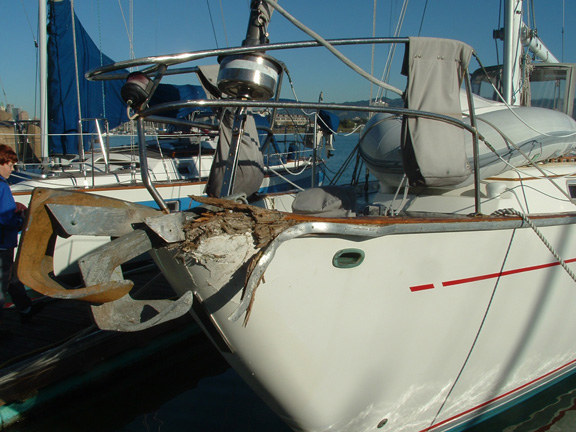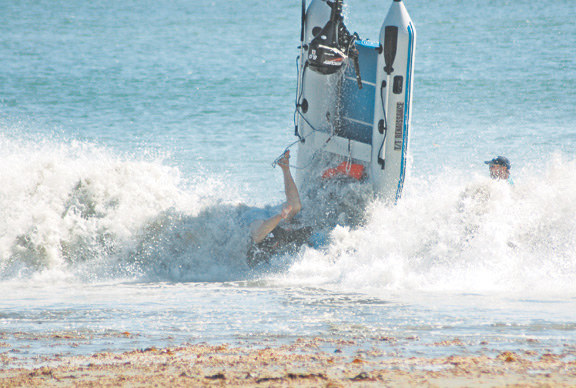
A Warning to All

Call it Murphy’s Law, or just bad luck, but sometimes trouble strikes in the final phase of an otherwise uneventful journey. It happened to Nigel Tetley near the end of the famous Golden Globe Race – a shoe-in for the fastest time, his boat broke up 2,000 miles from finishing the first solo ’round-the-world race. It happened to voyager William Peterson – he was forced to abandon his Newport 40 after dismasting several hundred miles short of completing a nine-year circumnavigation. And it just happened to a delivery crew bringing the Celestial 48 Tamara Lee Ann back to Alameda from the Baja Ha-Ha.
After an otherwise trouble-free 1,250-mile bash up the coast, the crew apparently lost their concentration momentarily while entering the Oakland Estuary and slammed into a set of pilings near the Alameda Ferry doing six knots. The boat’s permanent slip lay only a mile away.
We air this sad tale here not to beat up on the delivery crew – hey, s__t happens, especially in the realm of sailing – but as a warning to everyone to always keep a proper watch and anticipate potential mishaps, even when you think you’re home free.
Adventure of a Lifetime
©2007 Latitude 38 Media, LLC
That’s what the brochures said, and that’s what the 100 passengers aboard the 250-ft ‘eco-cruise ship’ Explorer got. In a scenario way too close for comfort to the Titanic, the 2,400-ton Canadian Explorer hit ice and began sinking. The incident happened in the wee hours of November 23 during one of the ship’s regular runs to Antarctica — an increasingly popular cruise destination. Unlike on the Titanic, the crew maintained order and got all 100 passengers and 45 crew into lifeboats. They were later picked up by larger Norwegian cruise ship Nord-norge.
Although everyone had a good chill in the 20-degree air, no injuries whatsoever were reported in the incident. Explorer’s captain and mate stayed aboard for a time in a last-ditch effort to save the ship, but they, too, were eventually evacuated. The 40-year-old ship sank in 2,000 feet of water about 25 miles from King George Island in the South Shetlands. The irony was not lost on anyone that the unspoilt, pristine beauty they had paid $7,000 to $16,000 apiece to see is what did the ship in.
Avoiding Dinghy Disasters

© Latitude 38 Media, LLC
With the start of another cruising season, we’ll remind readers that dinghy landings can be extremely dangerous. If you’re not careful, you could be injured or even killed, as an outboard prop can rip right through flesh. Here are some guidelines to follow.
When going ashore:
1) Always wear a lifejacket.
2) Always wear the engine kill switch on your wrist so the prop will stop if you flip.
3) Don’t become a sitting duck for waves by overloading your dinghy. Two fast trips are dryer than one short one.
4) Pick your landing site carefully, as some spots are usually calmer than others.
5) Be patient. You might have to wait five minutes or more to find a good lull. Most flips and dunkings occur because people weren’t patient.
6) Sometimes the surf is too big or the waves are too hollow for a safe landing. Wait until it’s safe.
7) If you’ve never taken a dinghy through the surf before, watch the technique of experienced people first, or take a panga to the beach.
8) Ride in on the back — not the crest — of a wave, then go like hell. As soon as it’s shallow enough for you and your crew to hop out, kill the engine, jump out, and charge to shore. Speed is the key to success.
9) If you ever get sideways to a wave, kill the engine immediately! Chances are you’re going to flip.
10) If a wave overtakes you from behind, kill the engine immediately! Chances are you’re going to flip.
11) Never stand between the dinghy and shore. If a wave slaps into the dinghy, it will knock you on your ass and be washed right over you.
When going back out:
1) Going out is even harder than coming ashore, because you’re going into the waves rather than with them, and because you’ll have much less time between waves.
2) Follow all safety instructions as for ‘Going Ashore’.
3) While in knee-deep water, be prepared, with entire crew instantly ready to jump in, outboard all ready to fire up, and the kill switch on your wrist. Never stand between your dinghy and the shore, you’ll get knocked on your ass.
4) Be patient! It’s even more important to get a great lull when going out than coming in.
5) As soon as the soup from the last wave before the lull has gone by you, go like hell until thigh-deep water, have everyone jump in instantly, fire up that engine, and go! You should look like a commando team.
5) Most folks get drenched because they overload their dinghies or take forever to get their crew in and get the engine started. You have less than 10 seconds if you’re going to be going through a breaking wave. It’s all about speed, speed and more speed.
6) Always head directly through the wave, never diagonally.
7) No matter what happens, never let your occupied dinghy get sideways to a breaking wave. You’ll surely roll, and people will get hurt. If you see that this will be unavoidable, always be ready to kill the engine before you lose complete control.
8) If it’s obvious that you’re not going to make it through a big wave, kill the engine, and have everyone get as far away from the dinghy as possible — instantly. Speed is of the essence.
9) Just because you made it over one swell doesn’t mean the next one won’t get you. Go! Go! Go! until you’re in deep water.
10) Sometimes you’ll have to walk your dinghy out until you’re nearly chest-high in water to make it through the waves. Sometimes you simply can’t make it out. In those cases during the Ha-Ha, we take a panga taxi instead.
Please be safe out there!
Atlantic Rally for Cruisers Underway
The 22nd Atlantic Rally for Cruisers (ARC) kicked off yesterday morning with 235 boats sailing across the starting line in fresh 20-knot winds. Racers are undoubtedly pleased that the 2,700-mile jaunt to the Caribbean island of St. Lucia is expected to be done entirely in idyllic tradewind conditions.

© Latitude 38 Media, LLC
Once again, the ARC is offering armchair enthusiasts the chance to follow the fleet at www.worldcruising.com/arc/viewer.aspx. For more on the rally, head on over to www.worldcruising.com/arc.
